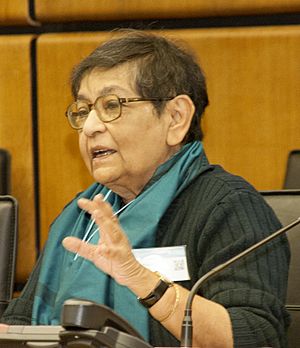Arundhati Ghose facts for kids
Quick facts for kids
Arundhati Ghose
|
|
|---|---|

Ghose speaking at the CTBT Diplomacy and Public Policy course in Vienna, July 2013
|
|
| Permanent Representative of India to the UN Office in Geneva | |
| IFS | |
| In office 1995–1997 |
|
| Indian Ambassador to the Arab Republic of Egypt | |
| In office 1992–1995 |
|
| Personal details | |
| Born | 25 November 1939 |
| Died | 25 July 2016 (aged 76) |
| Nationality | Indian |
| Alma mater | Lady Brabourne College |
| Occupation | Diplomat |
Arundhati Ghose (born 25 November 1939 – died 25 July 2016) was an important Indian diplomat. A diplomat is someone who represents their country in other nations. She was India's top representative to the UN Offices in Geneva.
She also led the Indian team during talks for the Comprehensive Nuclear-Test-Ban Treaty (CTBT) in 1996. This treaty aimed to stop all nuclear weapon tests. Before that, she served as India's Ambassador to countries like South Korea and Egypt.
Contents
Growing Up and Education
Arundhati Ghose grew up in Mumbai, a big city in India. She went to school at Cathedral and John Connon School. Later, she studied at Lady Brabourne College in Kolkata and then at Visva-Bharati University in Santiniketan.
In 1963, she joined the Indian Foreign Service. This is a special group of people who work for the Indian government in other countries.
Arundhati Ghose came from a well-known Bengali family. Her sister, Ruma Pal, was a judge in India's highest court, the Supreme Court of India. Her brother, Bhaskar Ghose, used to be in charge of a big public broadcasting company called Prasar Bharati. She was also the aunt of a journalist named Sagarika Ghose.
Her Diplomatic Career
During her career, Arundhati Ghose worked in many different countries. She served in places like Austria, the Netherlands, and Bangladesh. She also worked at India's main office in New York, which represents India at the United Nations.
In 1971, she played a key role during the war that led to Bangladesh's independence. She was the main link between India and the Bangladeshi government that was working from outside their country.
Standing Up for India's Position
In 1996, Ghose was chosen to lead India's team at the CTBT conference in Geneva. This was a very important meeting. India had nuclear technology but was not recognized as a nuclear power by some countries. India also did not want to sign the Nuclear Non-proliferation Treaty (NPT). This treaty allowed some countries to have nuclear weapons but tried to stop others from getting them.
India believed that all countries should either give up nuclear weapons or all countries should be allowed to develop them. Arundhati Ghose strongly stood up for India's position. She resisted pressure from Western countries that wanted India to sign the CTBT. Because of her strong stance, she became very well-known in India.
She retired from her diplomatic service in November 1997.
After Retirement
Even after retiring, Arundhati Ghose remained very active until she passed away from cancer in 2016.
She was a member of the Union Public Service Commission (UPSC) from 1998 to 2004. The UPSC helps the Indian government hire people for important jobs. She also advised the UN Secretary General on matters related to disarmament, which means reducing weapons. This was from 1998 to 2001.
From 2004 to 2005, she was India's representative to a committee that looked at economic, social, and cultural rights. She also served on the Executive Council of the Institute for Defence Studies and Analyses from 2004 to 2007. In 2007, she was part of a special group set up by the Ministry of External Affairs to work on non-proliferation and disarmament.
Awards and Honours
- Friends of Liberation War Honour from the Government of Bangladesh on 27 March 2012.
See also
- Navtej Sarna
- Taranjit Singh Sandhu
- Harsh Vardhan Shringla

